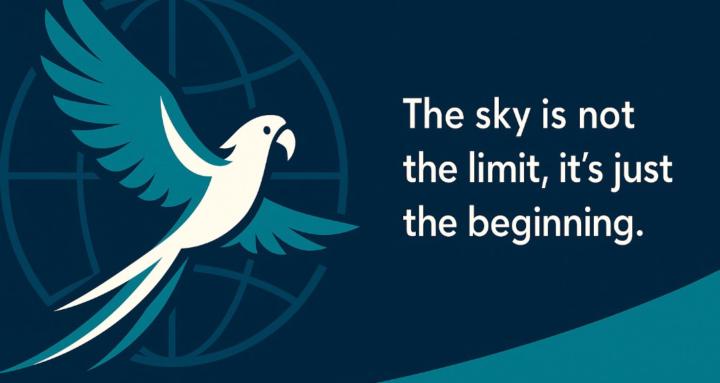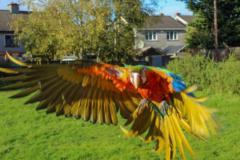
Write something
Pinned
Welcome to The Flight Crew!
This is the global community for free-flight parrot enthusiasts — whether you’re a beginner just starting out or an experienced flyer logging regular sessions. Here’s how to get started: 1. Introduce yourself: Comment below with: - Your bird’s species and name - Your location (city/country is enough) - Your #1 question about free-flight 2. Check the pinned posts: - Safety Checklist (must-read before outdoor flights)https://www.skool.com/the-flight-crew-9880/free-flight-safety-checklist-read-before-flying?p=efaf7a79 - Flight Log Template (for sharing and learning)https://www.skool.com/the-flight-crew-9880/flight-log-template?p=fc6f301f - Lost & Found Template (for emergencies)https://www.skool.com/the-flight-crew-9880/lost-found-template?p=767917c2 3. Follow the community rules: - Always put safety first - Be respectful and positive - Stay on-topic 4. Join the conversation Ask questions, share wins, and post your flight logs. Rule of thumb: safety first, respect always. We’re here to help each other fly further, safer, and smarter. The sky is not the limit — it’s just the beginning. — Steven
Pinned
Free-Flight Safety Checklist (Read Before Flying!)
Free-flight is beautiful, but it carries real risks. This checklist blends parrot training, falconry insights, and aviation-style risk control. Work through it before every outdoor session. 1) Foundations - Flock bond: Your bird sees you as flock and safe base. - Recall: 100% reliable indoors; whistle or cue paired with marker (“good!”/click). - Feeding strategy: Indoors/crate/home = pellets + veg (e.g., Harrison’s). Outside = nuts/fruit only for recalls and voluntary returns. - Health baseline: Vet cleared + weekly weight log to spot trends. 2) Outdoor Acclimation - Regular crate/home time outdoors until bird is calm: eating, preening, relaxing. - Crate/home always stocked with fresh water + pellets/veg so it feels safe and rewarding. - Gradual noise exposure (cars, kids, dogs, wind, distant crows). 3) Site & Weather - Home base: open sightlines, low canopy, away from roads/wires. - Wind/thermals: Light breeze only; avoid gusts/mid-day thermals. - Temperature guardrails (falconry-inspired): generally 5–28 °C (colder = calorie burn, hotter = overheating). Adjust by species. - Sky scan before each flight (hawks, crows, dogs). - Dusk rule: Always finish ≥2 hours before sunset so returns happen in daylight. 4) Session Flow - Pre-check: Bird keen & responsive, environment secure, weather within limits. - Short & calm: Early sessions = 2–5 minutes of hops/recalls. - High-value pay: Nuts/fruit only outside. Pellets/veg = crate/home meals. - End on a win: Invite back to crate/home → stocked with pellets/veg. Close calmly once inside. - Never chase: Stay at home base; let the bird return by choice. 5) Risk Controls - “Never one more try.” Stop before fatigue or frustration. - Stress signals: panting, shaking, frantic scanning, refusal to eat = stop now. - Distraction ladder: Empty field → light breeze → distant people/dogs → new-but-similar site → busier park. Only climb when recall is rock-solid. - Flight log: Record date, site, wind/temp, reps, recall %, behaviour, lessons. - Buddy system (optional improvement): When possible, have a second person — one flies, one scans. Not always doable, but safer when available.
2
0
Pinned
Flight Log Template
Use this template every time you share a flight log. It keeps things consistent and makes it easy to learn from each other. Copy → Paste → Fill in your details: Species/Age: Location & Weather: (include wind speed, temperature, visibility) Duration / Altitude: (approx flight time, height) Recall %: (e.g. 8/10 recalls successful) GPS Screenshot (if used): Behaviours Observed: (loops, perching, check-ins, distractions) Lesson Learned: Next Adjustment: Tips for posting logs: - Keep them brief but clear — bullet points are fine. - Add a photo or short video if possible (helps others see context). - Be honest: near misses and mistakes help everyone learn. - Edit your post later with updates (improved recall %, different weather, etc). Why this matters: Flight logs aren’t just a diary. They build a global record of safe practices for free-flight parrots. Beginners learn, veterans stay sharp, and the whole flock benefits.
2
0
Meet Bigbie
Bigbie is my 5 year old free flight trained harlaquin macaw. This was when he was 2 years old .

Lost & Found Template
If your bird is lost or sighted, please copy → paste → fill in this template when you post. It gives the community the best chance of helping quickly. Species + Name: Last Seen (time & exact location): Tracker Used (GPS/Radio/None): Do / Don’t Approach Notes: (e.g. “Very shy, don’t chase”) Owner Contact: (phone/email/DM preferred) Photo (if possible): Tips for urgent cases: - Post immediately — don’t wait to “look more.” - Stay calm, keep a safe spot with familiar perch/crate ready. - Use high-value food and familiar calls/whistles. - Check the last GPS ping if using a tracker. - Keep updates in the same thread so helpers see the full story. - Once resolved, edit your title with [RESOLVED]. Why this matters: In a lost bird emergency, clarity saves time. The faster we have full details, the faster nearby members can help.
1-6 of 6
powered by

skool.com/the-flight-crew-9880
Global free-flight parrot community for beginners & pros. Safety Q&As, flight logs, meet-ups, gear, and camaraderie for open-sky adventurers.
Suggested communities
Powered by

